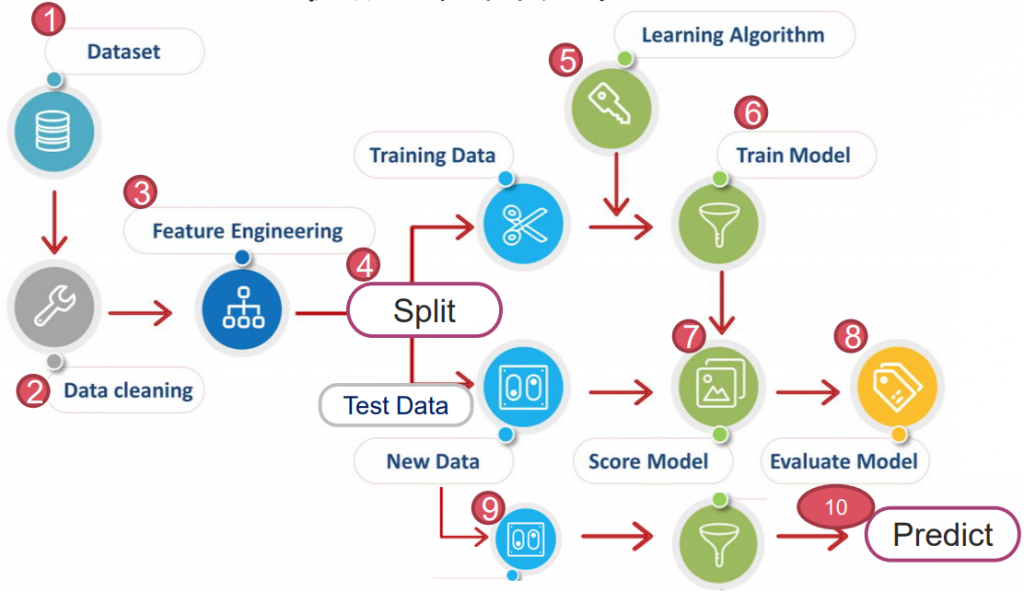
https://yourfreetemplates.com/free-machine-learning-diagram/
上一章提到的基礎學習(又稱弱學習)於多數真實情況下的性能其實並不好。
低維資料時具有較高的標準差,高維資料時則是變異太大導致穩定性不夠。
為了降低模型變異及提高準確度,可根據不同的數據,於各階段使用不同的演算法來訓練模型。
最終以不同權重的方式結合每個結果,得到一個更優性能的學習器。
核心理念:透過組合多個弱學習器,從而創建一個強學習器(或稱「集成學習」)。
當數據非常複雜,或有多種潛在的假設時,集成學習非常實用。
這是最簡單的集成學習。
將資料丟進 n 個「不同的弱學習器」,求出測試資料的預測結果,將結果向量相加。
因為分類只有 0/1,新的結果向量裡的值最大為 n,最小為0。
透過投票,至少有過半數以上的學習器預測 1,才判定結果是 1,其餘則為 0。
投票方法又分兩種:
硬投票:預測結果是所有投票結果最多出現的類。
軟投票:預測結果是所有投票結果中「概率和」最大的類。
如:預測某樣本的結果為 70%、51%、1%,硬投票會判定為正樣本(2 正 1 負),但軟投票則會判定為負樣本(70%+51%+1% < 30%+49%+99%)。
優點:簡單快速,不需調整過多參數。
缺點:學習器種類上限會限制其精確度。
以鳶尾花為例,且故意拿掉部分 y 與特徵(使模型預測較不準):
from sklearn import datasets
from sklearn.preprocessing import LabelEncoder
from sklearn.model_selection import train_test_split
ds = datasets.load_iris()
X, y = ds.data[50:, [1, 2]], ds.target[50:]
y = LabelEncoder().fit_transform(y)
X_train, X_test, y_train, y_test = train_test_split(X, y, test_size=0.5, random_state=1, stratify=y)
# 三個弱學習器:此處用邏輯斯迴歸、決策樹和 KNN
from sklearn.pipeline import make_pipeline
from sklearn.preprocessing import StandardScaler
from sklearn.linear_model import LogisticRegression
from sklearn.tree import DecisionTreeClassifier
from sklearn.neighbors import KNeighborsClassifier
from sklearn.model_selection import cross_val_score
from sklearn.ensemble import RandomForestClassifier
lr_PL = make_pipeline(
StandardScaler(),
lr = LogisticRegression(penalty='l2', C=0.001, random_state=1)
)
dt_PL = make_pipeline(
DecisionTreeClassifier(max_depth=1, criterion='entropy', random_state=0)
)
knn_PL = make_pipeline(
StandardScaler(),
KNeighborsClassifier(n_neighbors=1, metric='minkowski')
)
all_clf = [lr_PL, dt_PL, knn_PL]
from sklearn.ensemble import VotingClassifier
ens = [('LR', lr_PL), ('DT', dt_PL), ('KNN', knn_PL)]
vc = VotingClassifier(ens, voting='soft')
clf_labels = ['Logistic regression', 'Decision tree', 'KNN', 'Voting Classifier']
all_clf = [lr_PL, dt_PL, knn_PL, vc]
# 使用 cross validation 避免過擬合
from sklearn.model_selection import cross_val_score
for clf, label in zip([lr_PL, dt, knn_PL], clf_labels):
scores = cross_val_score(
clf, X_train, y_train,
cv=10,
scoring='roc_auc'
)
print(f"ROC AUC: {scores.mean():0.2f} (+/- {scores.std():0.2f}) [{label}]")
>> ROC AUC: 0.92 (+/- 0.15) [Logistic regression]
ROC AUC: 0.87 (+/- 0.18) [Decision Tree]
ROC AUC: 0.85 (+/- 0.13) [KNN]
ROC AUC: 0.98 (+/- 0.05) [Voting Classifier]
把決策邊界作圖(代碼在補充 1.):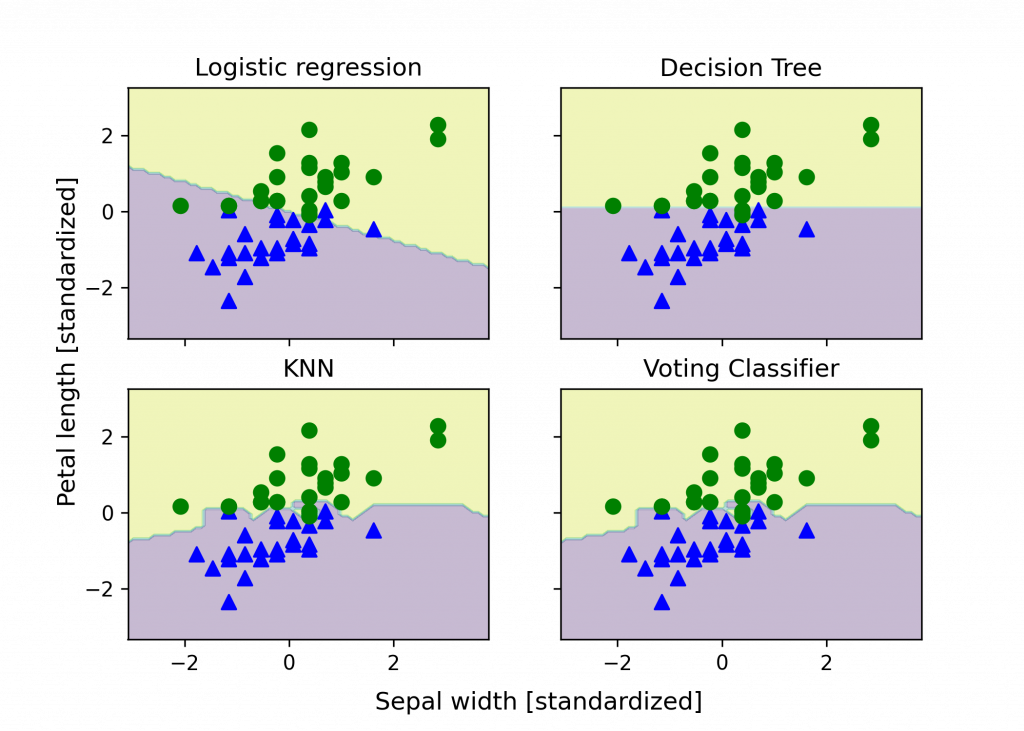
直接投票法的問題-學習器種類有限,僅憑數個演算法,可能無法達到專案需求的精度。
因此,人們發明 Bootstrap AGGregatING,也就是 Bagging 裝袋法來解決。
選定一弱學習器。將原樣本做「會放回抽樣」,生成 n 個與原數據一樣大的「自助樣本」。
(因此,某些樣本點可能在自助樣本中出現多次,某些則被忽略)
學習器會將每個自助樣本都訓練,最終產出 n 個模型。藉投票決定將測試樣本分派(預測)到哪個類別。
優點:從樣本隨機抽樣,降低雜訊被重複訓練到的機率,進而提升模型穩定性。
缺點:只是將每次的錯誤率稀釋掉,實際模型依舊沒有學的更好。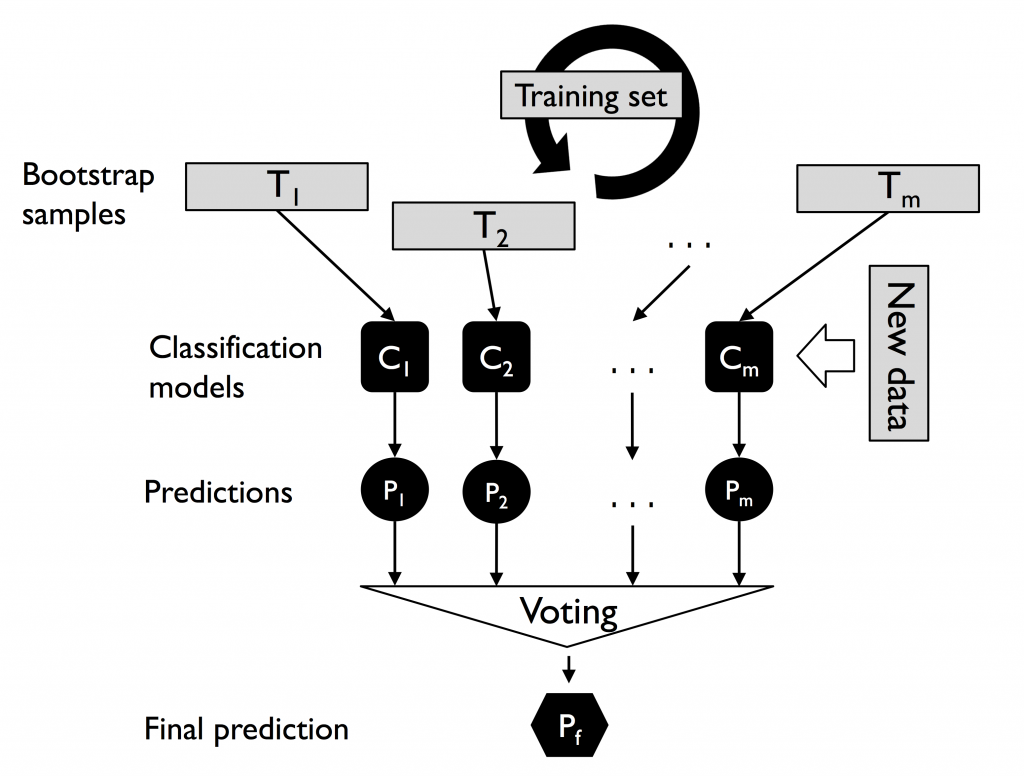
以紅酒分類為例:
from sklearn.datasets import load_wine
X, y = load_wine(return_X_y=True)
from sklearn.preprocessing import LabelEncoder
from sklearn.model_selection import train_test_split
le = LabelEncoder()
y = le.fit_transform(y)
X_train, X_test, y_train, y_test = train_test_split(X, y, test_size=0.2, random_state=1, stratify=y)
from sklearn.tree import DecisionTreeClassifier
from sklearn.ensemble import BaggingClassifier
tree = DecisionTreeClassifier(criterion='entropy', random_state=1)
bag = BaggingClassifier(
base_estimator=tree,
n_estimators=500,
max_samples=1.0,
max_features=1.0,
bootstrap=True,
bootstrap_features=False,
n_jobs=1,
random_state=1
)
超參數:
1. nestimators: 創建 n 個子模型。默認 10。
2. maxsamples: 每個子模型使用 n 個樣本數據訓練。默認 1.0。
3. maxfeatures: 若是 int,則選取 n 個特徵;若是 float 則選取 n\X.shape[1] 個特徵。默認 1.0。
4. bootstrap: 在隨機選取樣本時是否將已選樣本放回。默認 True。
5. bootstrapfeatures: 在隨機選取特徵時是否將已選特徵放回。默認 False。
6. njobs: 用於訓練和預測所需要 CPU 的數量(-1 表使用所有空閒 CPU)。
接著比較一下 一般決策樹 vs. Bagging 決策樹(就是隨機森林)
# 1. 決策樹
from sklearn.metrics import accuracy_score
tree.fit(X_train, y_train)
y_train_pred = tree.predict(X_train)
y_test_pred = tree.predict(X_test)
tree_train = accuracy_score(y_train, y_train_pred)
tree_test = accuracy_score(y_test, y_test_pred)
print(f'Decision tree train/test accuracies {tree_train:.3f} / {tree_test:.3f}')
# 2. Bagging
bag.fit(X_train, y_train)
y_train_pred = bag.predict(X_train)
y_test_pred = bag.predict(X_test)
bag_train = accuracy_score(y_train, y_train_pred)
bag_test = accuracy_score(y_test, y_test_pred)
print(f'Bagging train/test accuracies {bag_train:.3f} / {bag_test:.3f}')
>> Decision tree train/test accuracies 1.000 / 0.833
Bagging train/test accuracies 1.000 / 0.917
把決策邊界作圖(代碼在補充 2.):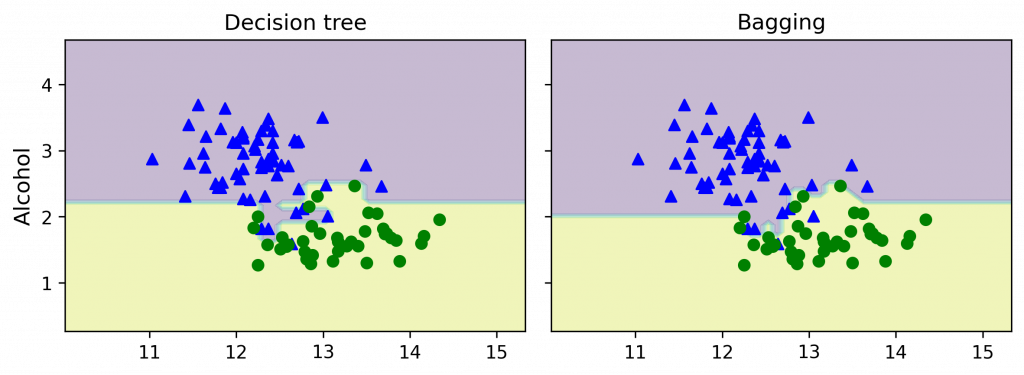
基於決策樹演算法上,透過 Bagging 演算法,讓多顆樹生長且不進行剪枝,
並對這些樹的結果進行組合(分類用簡單多數投票法,迴歸則用平均法)。
優點:可以處理分類與迴歸資料。接受高維度資料。非平衡誤差資料時能平衡誤差。
缺點:需大量記憶體儲存每顆樹的資訊。無法針對單一顆樹作解釋。
from sklearn.datasets import load_boston
ds = datasets.load_breast_cancer()
X=pd.DataFrame(ds.data, columns=ds.feature_names)
y=pd.DataFrame(ds.target, columns=['Cancer'])
from sklearn.model_selection import train_test_split
X_train, X_test, y_train, y_test = train_test_split(X, y, test_size = 0.3)
from sklearn.ensemble import RandomForestClassifier as RFC
rfc = RFC(n_estimators=100, criterion='gini', max_depth=3, random_state=1)
超參數:
1. nestimators: 要種幾棵樹。默認 100。
2. criterion: 不純度方法,'gini' & 'entropy'。默認 gini。
3. maxdepth: 樹的分裂層數。若 None,則擴展節點至所有葉 minsamplessplit 樣本。默認 None。
4. minsamplessplit: 分裂一個內部節點所需的最小樣本數。默認 2。
rfc.fit(X_train, y_train)
rfc.score(X_test, y_test)
>> 0.9415204678362573
Boosting 是指能夠將弱學習器轉化爲強學習器的一系列算法。
概念類似 Bagging,不同的是,它會將前一次學習器「分類錯誤的資料」的權重提高,以訓練下一次。
學習器會學習到上一次「錯誤分類資料」的特性,進而提升分類結果。
優點:一般來說可得到比 Bagging 更好的結果。
缺點:若原生資料集雜訊太多,易使模型放大對雜訊的判斷,導致結果失準。
以紅酒分類為例,:
from sklearn.datasets import load_wine
X, y = load_wine(return_X_y=True)
from sklearn.preprocessing import LabelEncoder
from sklearn.model_selection import train_test_split
le = LabelEncoder()
y = le.fit_transform(y)
X_train, X_test, y_train, y_test = train_test_split(X, y, test_size=0.2, random_state=1, stratify=y)
from sklearn.tree import DecisionTreeClassifier
from sklearn.ensemble import AdaBoostClassifier
tree = DecisionTreeClassifier(criterion='entropy', max_depth=1, random_state=1)
ada = AdaBoostClassifier(
base_estimator=tree,
n_estimators=500,
learning_rate=0.01,
random_state=1
)
超參數:
1. nestimators: 創建 n 個學習器。默認 50。
2. learningrate: 學習速率。默認 1.0。
接著比較一下 一般決策樹 vs. Boosting 決策樹
from sklearn.metrics import accuracy_score
tree.fit(X_train, y_train)
y_train_pred = tree.predict(X_train)
y_test_pred = tree.predict(X_test)
tree_train = accuracy_score(y_train, y_train_pred)
tree_test = accuracy_score(y_test, y_test_pred)
print(f'Decision tree train/test accuracies {tree_train:.3f}/{tree_test:.3f}')
ada.fit(X_train, y_train)
y_train_pred = ada.predict(X_train)
y_test_pred = ada.predict(X_test)
ada_train = accuracy_score(y_train, y_train_pred)
ada_test = accuracy_score(y_test, y_test_pred)
print(f'AdaBoost train/test accuracies {ada_train:.3f}/{ada_test:.3f}')
>> Decision tree train/test accuracies 0.916/0.875
AdaBoost train/test accuracies 0.968/0.917
把決策邊界作圖(代碼在補充 3.):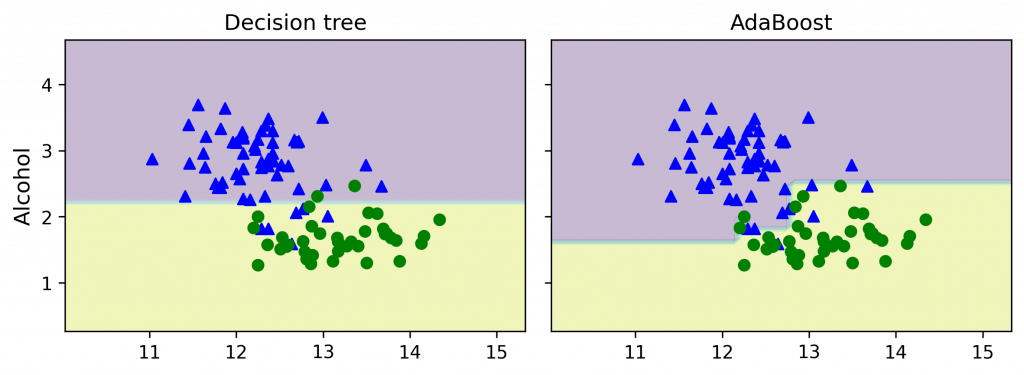
其原理與 Ada 類似,差別在前者利用「分類錯誤資料」權重定位模型的不足,後者則是透過「梯度」。
原理可參考文章 1、文章 2 & 文章 3
最有名的莫過於是 XGBoost。
XGBoost 全名 eXtreme Gradient Boosting,是 Kaggle 競賽中常見的演算法。
它保有 Gradient Boosting 的做法,使後生成樹能修正前棵樹的錯誤。
此外,如隨機森林,生成每棵樹時會隨機抽取特徵,使每棵樹的生成不會拿全部的特徵參與決策。
故可實現平行處理。並不是說可以平行處理多顆樹,而是指它可平行處理特徵選取的計算。
可說是同時結合 Bagging 和 Boosting 的優點。
為抑制模型複雜化,XGboost 在目標函數添加了 Regularization。
模型在訓練時為了擬合訓練資料,會產生很多高次項的函數,但反而容易被雜訊干擾導致過度擬合。
因此 L1/L2 使損失函數更平滑,抗雜訊干擾能力更大。
最後 XGboost 用到了一 & 二階導數來生成下一棵樹。
其中 Gradient 就是所謂的一階導數,而 Hessian 即為二階導數。
優點:準確率高。支援平行處理。抗過擬合與抗雜訊能力強。
# 同樣用上面的酒類分類
from sklearn.tree import DecisionTreeClassifier
from xgboost import XGBClassifier
tree = DecisionTreeClassifier(criterion='entropy', max_depth=1, random_state=1)
xgb = XGBClassifier(
n_estimators=500,
learning_rate=0.01,
random_state=1
)
超參數:
1. nestimators: 創建 n 個學習器。
2. maxdepth: 樹的最大深度,(通常設計 3~10)。默認 6。
3. booster: gbtree 樹模型(默認) / gbliner 線性模型。
4. learningrate: 學習速率,(通常設計 0.01~0.2)。默認 0.3。
完整可看: https://www.twblogs.net/a/5db37e49bd9eee310ee694ee
與前面 Baggin / Boosting 不同,Stacking 會有兩種模型:
同樣用上面的酒類分類:
from sklearn.pipeline import make_pipeline
from sklearn.preprocessing import StandardScaler
from sklearn.tree import DecisionTreeClassifier
from sklearn.neighbors import KNeighborsClassifier
from sklearn.linear_model import LogisticRegression
from sklearn.ensemble import StackingClassifier
tree = DecisionTreeClassifier(criterion='entropy', max_depth=1, random_state=1)
knn_PL = make_pipeline(
StandardScaler(),
KNeighborsClassifier(n_neighbors=1, metric='minkowski')
)
esn = [('Decision Tree', tree), ('KNN', knn_PL)]
stk = StackingClassifier(
estimators=esn,
final_estimator=LogisticRegression()
)
*超參數:
from sklearn.metrics import accuracy_score
from sklearn.model_selection import cross_val_score
labels = ['Random Forest', 'SVC', 'Stacking']
all_clf = [rf, svc_PL, stk]
for clf, label in zip(all_clf, labels):
scores = cross_val_score(
clf, X_train, y_train,
cv=10,
scoring='roc_auc'
)
print(f"ROC AUC: {scores.mean():0.2f} (+/- {scores.std():0.2f}) [{label}]")
>> ROC AUC: 0.88 (+/- 0.09) [Decision Tree]
ROC AUC: 0.90 (+/- 0.11) [KNN]
ROC AUC: 0.98 (+/- 0.05) [Stacking]
把決策邊界作圖(代碼在補充 4.):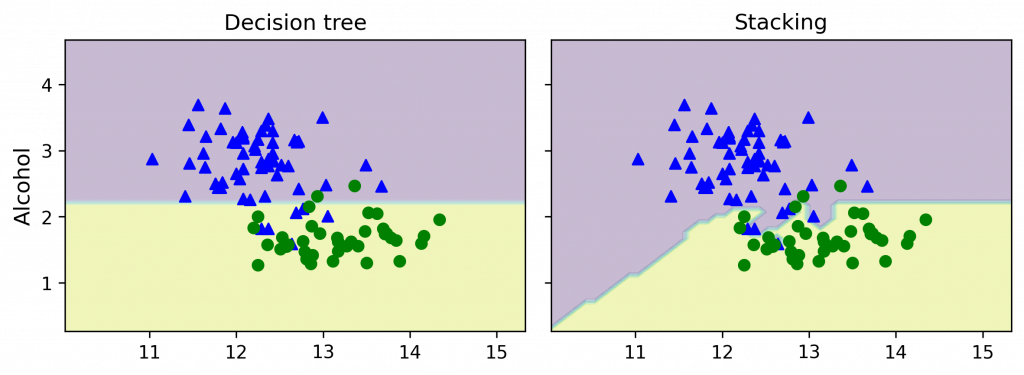
sc = StandardScaler()
X_train_std = sc.fit_transform(X_train)
import numpy as np
from itertools import product
x_min, x_max = X_train_std[:, 0].min() - 1, X_train_std[:, 0].max() + 1
y_min, y_max = X_train_std[:, 1].min() - 1, X_train_std[:, 1].max() + 1
xx, yy = np.meshgrid(np.arange(x_min, x_max, 0.1),
np.arange(y_min, y_max, 0.1)
)
f, axarr = plt.subplots(nrows=2, ncols=2,
sharex='col',
sharey='row',
figsize=(7, 5))
for idx, clf, tt in zip(product([0, 1], [0, 1]), all_clf, labels):
clf.fit(X_train_std, y_train)
Z = clf.predict(np.c_[xx.ravel(), yy.ravel()])
Z = Z.reshape(xx.shape)
axarr[idx[0], idx[1]].contourf(xx, yy, Z, alpha=0.3)
axarr[idx[0], idx[1]].scatter(X_train_std[y_train==0, 0],
X_train_std[y_train==0, 1],
c='blue',
marker='^',
s=50)
axarr[idx[0], idx[1]].scatter(X_train_std[y_train==1, 0],
X_train_std[y_train==1, 1],
c='green',
marker='o',
s=50)
axarr[idx[0], idx[1]].set_title(tt)
plt.text(-3.5, -5.,
s='Sepal width [standardized]',
ha='center', va='center', fontsize=12)
plt.text(-12.5, 4.5,
s='Petal length [standardized]',
ha='center', va='center',
fontsize=12, rotation=90)
plt.show()
*補充 2. 袋裝法 範例的決策邊界圖
import numpy as np
import matplotlib.pyplot as plt
x_min = X_train[:, 0].min() - 1
x_max = X_train[:, 0].max() + 1
y_min = X_train[:, 1].min() - 1
y_max = X_train[:, 1].max() + 1
xx, yy = np.meshgrid(np.arange(x_min, x_max, 0.1),
np.arange(y_min, y_max, 0.1))
f, axarr = plt.subplots(nrows=1, ncols=2,
sharex='col',
sharey='row',
figsize=(8, 3))
for idx, clf, tt in zip([0, 1],
[tree, bag],
['Decision tree', 'Bagging']):
clf.fit(X_train, y_train)
Z = clf.predict(np.c_[xx.ravel(), yy.ravel()])
Z = Z.reshape(xx.shape)
axarr[idx].contourf(xx, yy, Z, alpha=0.3)
axarr[idx].scatter(X_train[y_train == 0, 0],
X_train[y_train == 0, 1],
c='blue', marker='^')
axarr[idx].scatter(X_train[y_train == 1, 0],
X_train[y_train == 1, 1],
c='green', marker='o')
axarr[idx].set_title(tt)
axarr[0].set_ylabel('Alcohol', fontsize=12)
plt.tight_layout()
plt.show()
*補充 3. 強化法 範例的決策邊界圖
import numpy as np
import matplotlib.pyplot as plt
x_min, x_max = X_train[:, 0].min() - 1, X_train[:, 0].max() + 1
y_min, y_max = X_train[:, 1].min() - 1, X_train[:, 1].max() + 1
xx, yy = np.meshgrid(np.arange(x_min, x_max, 0.1),
np.arange(y_min, y_max, 0.1))
f, axarr = plt.subplots(nrows=1, ncols=2,
sharex='col',
sharey='row',
figsize=(8, 3))
for idx, clf, tt in zip([0, 1],
[tree, ada],
['Decision tree', 'AdaBoost']):
clf.fit(X_train, y_train)
Z = clf.predict(np.c_[xx.ravel(), yy.ravel()])
Z = Z.reshape(xx.shape)
axarr[idx].contourf(xx, yy, Z, alpha=0.3)
axarr[idx].scatter(X_train[y_train == 0, 0],
X_train[y_train == 0, 1],
c='blue', marker='^')
axarr[idx].scatter(X_train[y_train == 1, 0],
X_train[y_train == 1, 1],
c='green', marker='o')
axarr[idx].set_title(tt)
axarr[0].set_ylabel('Alcohol', fontsize=12)
plt.tight_layout()
plt.show()
*補充 4. 黏合法 範例的決策邊界圖
import numpy as np
import matplotlib.pyplot as plt
x_min, x_max = X_train[:, 0].min() - 1, X_train[:, 0].max() + 1
y_min, y_max = X_train[:, 1].min() - 1, X_train[:, 1].max() + 1
xx, yy = np.meshgrid(np.arange(x_min, x_max, 0.1),
np.arange(y_min, y_max, 0.1))
f, axarr = plt.subplots(nrows=1, ncols=2,
sharex='col',
sharey='row',
figsize=(8, 3))
for idx, clf, tt in zip([0, 1, 2],
[tree, stk],
['Decision tree', 'Stacking']):
clf.fit(X_train, y_train)
Z = clf.predict(np.c_[xx.ravel(), yy.ravel()])
Z = Z.reshape(xx.shape)
axarr[idx].contourf(xx, yy, Z, alpha=0.3)
axarr[idx].scatter(X_train[y_train == 0, 0],
X_train[y_train == 0, 1],
c='blue', marker='^')
axarr[idx].scatter(X_train[y_train == 1, 0],
X_train[y_train == 1, 1],
c='green', marker='o')
axarr[idx].set_title(tt)
axarr[0].set_ylabel('Alcohol', fontsize=12)
plt.tight_layout()
plt.show()
